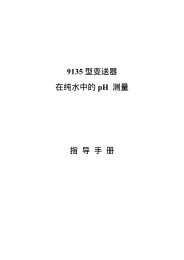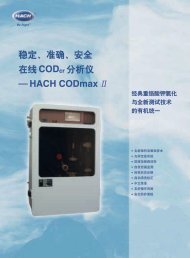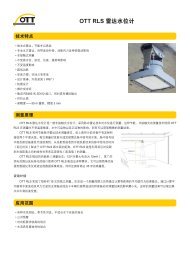TOC Analysis Moving from Laboratory Testing to On-line Analysis
TOC Analysis Moving from Laboratory Testing to On-line Analysis
TOC Analysis Moving from Laboratory Testing to On-line Analysis
Create successful ePaper yourself
Turn your PDF publications into a flip-book with our unique Google optimized e-Paper software.
LABORATORY WIDE-RANGING MEMBRANE CONDUCTIVITY <strong>TOC</strong> ANALYSERS<br />
<strong>Labora<strong>to</strong>ry</strong>-based <strong>TOC</strong> analysers utilise membrane conductivity (MC) with a CO2 permeable membrane<br />
and two conductivity cells <strong>to</strong> measure conductivity before and after oxidation of the organic material.<br />
Typically, the <strong>TOC</strong> analyser will have up <strong>to</strong> three conductivity probes; one for reporting conductivity and<br />
two <strong>to</strong> make the before- and after-oxidation measurements.<br />
MC technology was developed <strong>to</strong> provide a lab-based general purpose <strong>TOC</strong> analyser capable of<br />
measuring <strong>TOC</strong> in a wide range of water types. Interference <strong>from</strong> other salts and chemicals present in<br />
non-GMP waters is avoided as they cannot pass through the membrane, allowing the MC analyser <strong>to</strong> only<br />
report increases in conductivity <strong>from</strong> the evolved CO2 <strong>from</strong> the oxidised <strong>TOC</strong>. However, they are a flowthrough<br />
design and full oxidation the <strong>TOC</strong> is rarely achieved. Instead fac<strong>to</strong>rs are used <strong>to</strong> extrapolate the<br />
<strong>TOC</strong> <strong>from</strong> the slight changes in conductivity as the <strong>TOC</strong> is partially oxidised on it’s way through the<br />
analyser.<br />
This technology does not have a stable calibration and, if used for on-<strong>line</strong> analysis, is affected by<br />
temperature, pressure and flow rate changes in the PW or WFI system. Also, the CO2 transfer rate<br />
through the membrane is dependant on the pH and temperature of the water system. Slight drift in the<br />
calibration of the multiple conductivity cells used can also contribute <strong>to</strong> inaccurate <strong>TOC</strong> analysis. In fact,<br />
when this technology is used in the labora<strong>to</strong>ry, a calibration check is frequently recommended for each<br />
batch of <strong>TOC</strong> samples run <strong>to</strong> ensure that the analyser calibration has not drifted.<br />
<strong>TOC</strong> <strong>Analysis</strong> – <strong>Moving</strong> <strong>from</strong> labora<strong>to</strong>ry <strong>to</strong> on-<strong>line</strong> moni<strong>to</strong>ring.<br />
March 2008 by Hach Ultra<br />
Figure 1: Lab-based Membrane Conductivity <strong>TOC</strong> <strong>Analysis</strong><br />
ON-LINE DIRECT CONDUCTOMETRIC-BASED <strong>TOC</strong> ANALYSERS<br />
Direct Conduc<strong>to</strong>metric (DC) based <strong>TOC</strong> analysers, such as the Anatel PAT700, utilise a single<br />
conductivity meter <strong>to</strong> measure the increased conductivity of a water aliquot after all the organic material in<br />
the aliquot has been completely oxidised <strong>to</strong> carbon dioxide (CO2) using ultra-violet light.<br />
Because the water treatment system creating PW and WFI is designed <strong>to</strong> GMP-compliant quality water,<br />
there must be no potentially interfering contaminants present, so the membrane technology is not an<br />
advantage and, being much more stable and robust in design than membrane flow-through <strong>TOC</strong><br />
analysers, these DC <strong>TOC</strong> analysers are not affected by the temperature, pressure and flow changes<br />
expected on a typical PW or WFI system.<br />
As shown in Figure 2 below, the WFI or PW aliquot is trapped in the analysis cell by valves, the oxidising<br />
UV lamp is turned on and the organic materials are fully oxidised. The difference in conductivity created by<br />
2 of 7






